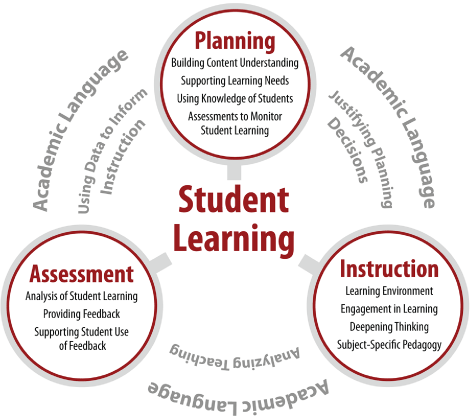Elementary Education edTPA Resources

Used with permission. Copyright © 2013 Board of Trustees of the Leland
Stanford Junior University. All rights reserved.
Welcome to the SIUE Elementary Education closed edTPA portal! The Placement Confirmation Letter containing the password that brought you to this page is an important document containing information about your Elementary teacher candidate, SIUE faculty who will be supporting your work as a teacher candidate mentor, and the SIUE policies that will govern your work. This password-protected webpage contains more detailed, private information about how SIUE is preparing your Elementary teacher candidate for the edTPA performance assessment which is required for initial licensure in Illinois.
The edTPA requires teacher candidates to complete three tasks. Task 1 is Planning for Instruction and Assessment. Task 2 is Instructing and Engaging Students in Learning. Task 3 is Assessing Student Learning. These three tasks represent a "cycle of effective teaching" (i.e., teaching that is focused on student learning). The planning task documents teacher candidates intended teaching, the instruction task documents their enacted teaching, and the assessment task documents the impact of their teaching on student learning.
The three tasks and the evidence they provide for each are framed by their understandings of students and their learning. As they develop, document, and teach lessons, they will reflect upon the cyclical relationship among planning, instruction, and assessment with a focus on their students’ learning needs.
An essential part of the assessment is the evidence teacher candidates will submit outlining how they planned, taught, and assessed their lessons to deepen student learning. This evidence includes both artifacts and commentaries.
Artifacts represent authentic work completed by the teacher candidate and their students. These include lesson plans, copies of instructional and assessment materials, video clips of their teaching, and student work samples.
Commentaries are opportunities teacher candidates have to describe their artifacts, explain the rationale behind their choice and use, and analyze and reflect on what they have learned about their teaching practice and their students’ learning. Note that although writing ability will not be scored directly, commentaries must be clearly written and well-focused.
Conceptually, the SIUE School of Education seeks to develop Inquirer-Professionals. As an entity within the School of Education, the SIUE Elementary Education licensure program has views the edTPA performance assessment as embodying key elements of teacher inquiry. As such, the program has embedded elements of this assessment within the professional education course work and clinical field work required for all Elementary teacher candidates. Reflecting on practice is not a new idea in teacher professional development. However, teacher inquiry is distinct from reflection (Dana & Yendol-Silva, 2003) in that it is more intentional and the results are made visible through such things as purposeful educative discussion, debate, and sharing. As a form of action research, teacher inquiry involves the following practices:
1. framing questions/ posing wonderings,
2. use of data collection strategies to gain insights into questions/wonderings,
3. analyzing data along with relevant literature to help make sense of data,
4. making or proposing changes to practice based on new understandings developed during the inquiry,
5. and sharing findings with others by making them public which includes being able to supporting conclusions with data and evidence.
There is a high level of alignment between the five practices of teacher inquiry identified above and "cycle of effective teaching." The three tasks outined in each edTPA handbook include having teacher candidates identify a "central focus" that aligns with the parameters identified in each edTPA handbook. Using this central focus, they then plan, implement, and reflect on a learning segment of 3-5 lessons. This includes video tape evidence and student work samples. This process reflects elements of teacher inquiry in that:
The work is undergirded by a driving force. However, in this case, it is an externally imposed design challenge, rather than a framing question or wondering. Ex: Task 1 of the Elementary Literacy Handbook requires teacher candidates to describe the central focus and purpose for the content they will teach in the learning segment. Once this is provided, they must describe how the standards and learning objectives within the learning segment address the central focus.
Data collection strategies are used to determine the impact of the instruction on various learner groups - this includes evidence from such sources as video taped segments of instruction & student work samples using appropriate tools such as rubrics.
Data is analyzed to determine teaching effectveness and to identify learning trends - this includes making connections to research and/or theory, creating a graphic or narrative that summarizes student learning, and the selection of three specific student cases in which to focus.
Written commentaries need to be drafted to describe “next steps” for instruction. These proposed next steps must be based on the learning trends and supported by principles from research and/or theory.
Commentaries require teacher candidates to justify decisions and conclusions by referencing relevant theory and/or data such specific points in the video and performance trends.